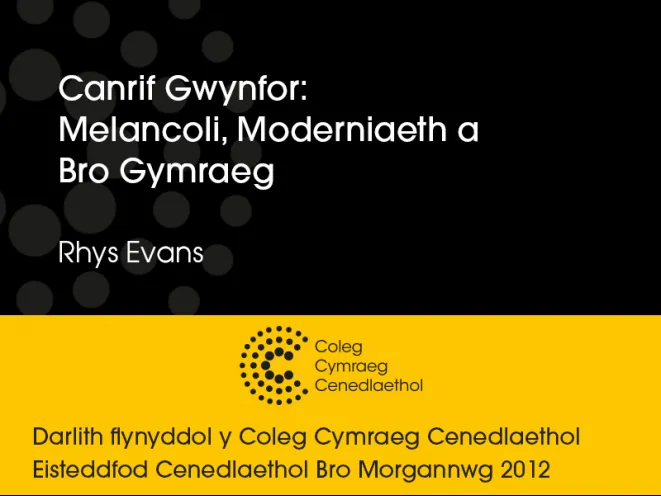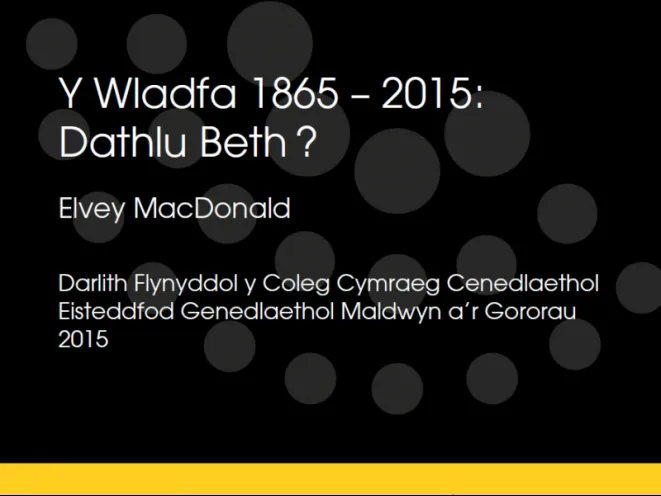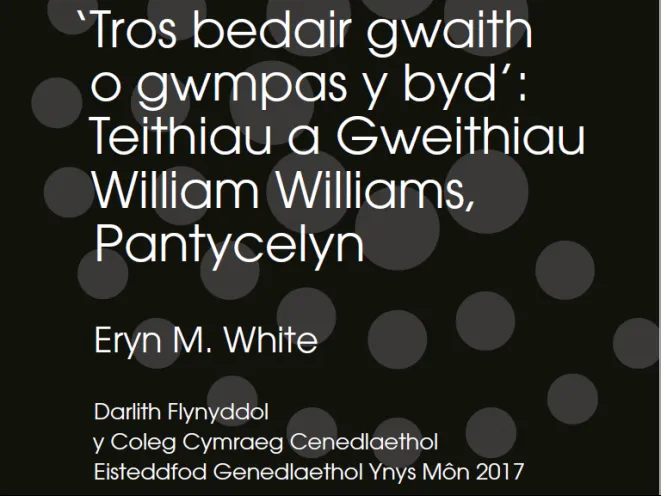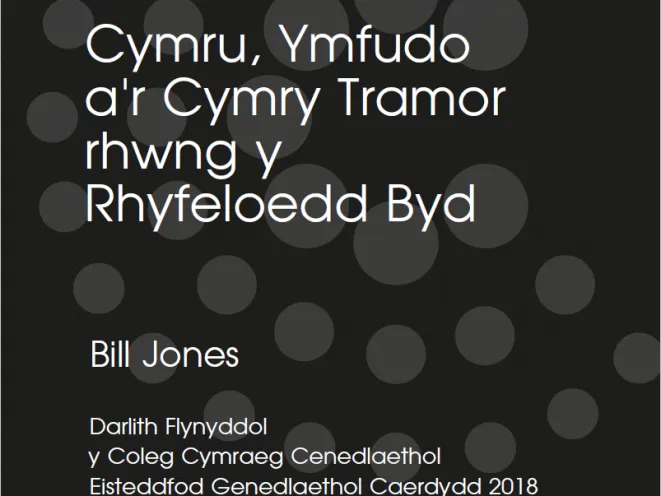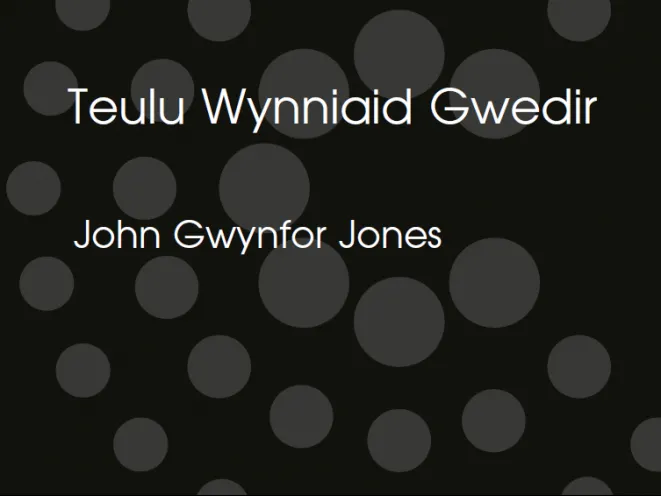With the uncertainty of climate change, reconstructions from parameteorological and phenological records provide a strong basis for the analysis of past and present climate. However, very little research has been completed on the historical climate of Wales, which is variable throughout the country due to factors such as topography and atmospheric circulation. This is particularly so for west Wales, which has a diverse range of environments from the upland ‘green desert’ to the fertile coastal plains, where an extensive history may potentially be reconstructed from un-tapped documentary resources. The potential is immense as possible sources of meteorological information include all religious, official and personal documentation, which may provide an insight into the relationship between the Welsh and the weather.
Historical climate: The potential of Wales’s documentary sources
Coffáu’r Rhyfel Mawr yng Nghymru – seminar gyda'r Athro Syr Deian Hopkin
Yr Athro Syr Deian Hopkin yn siarad â myfyrwyr ar 20 Mawrth 2014 ynglŷn â sut i goffáu’r Rhyfel Mawr yng Nghymru yn ystod canmlwyddiant dechrau'r rhyfel.
Cyflwyniad yr Athro Gareth Williams ar ysgrifau sydd wedi dylanwadu arno
Mae'r Athro Gareth Williams yn hanesydd disglair, yn arbenigo ar ddiwylliant poblogaidd yng Nghymru yn y 19eg a'r 20fed ganrif. Mae bellach yn Athro Emeritws Prifysgol De Cymru. Yma, mewn darlith a draddododd ym Mhrifysgol Abertawe ar 17 Ebrill 2013, mae'n trafod pa ysgrifau sydd wedi dylanwadu ar ei yrfa.
‘A new world where justice dwells’: Morgan John Rhys’ (1760–1804) vision
In this article it is argued how Morgan John Rhys’ (1760–1804) belief in the Second Coming and Millennium influenced his participation in the campaign to abolish slavery, the French Revolution and America. It is shown how Millenarianism was a force that shaped Morgan John Rhys’ worldview and influenced his social action and campaigns. Also, it is shown how William Williams, Pantycelyn (1717–91), preceded Morgan John Rhys in this context. My argument, with comparative reference to Williams and Rhys, is that Evangelicalism and the Enlightenment were not intellectual enemies, and that Millenarianism was one of the most important driving forces in the lives of these two men, who were integral to the life of eighteenth century Wales.
The early response to Williams Pantycelyn by Saunders Lewis
Saunders Lewis’ Williams Pantycelyn (1927) was the most exciting and controversial work of literary criticism to appear in twentieth century Welsh letters. In ten memorable and often brilliant chapters, Lewis analysed the work of the eighteenth century hymnist not according to the usual Protestant norms but in terms of medieval Catholic mysticism on the one hand and the then novel Freudian and Jungian psychology on the other. The book caused a literary and critical storm. Among those who affirmed its counterintuitive nature was the poet T. Gwynn Jones; its thesis was rejected by the philosopher E. Keri Evans while the preacher-poet Moelwyn Hughes found the volume objectionable in the extreme. Such was the power of Lewis’ analysis, however, that for more than a generation it came to embody a new orthodoxy in the scholarly understanding of William Williams. It was not until the 1960s that this orthodoxy began to be overturned. The accompanying essay describes how this process evolved.
Darlith Flynyddol 2012: Canrif Gwynfor – Melancoli, Moderniaeth a Bro Gymraeg
Darlith Flynyddol y Coleg Cymraeg Cenedlaethol 2012: Canrif Gwynfor - Melancoli, Moderniaeth a Bro Gymraeg, gan Rhys Evans Traddodwyd y ddarlith yn Eisteddfod Genedlaethol Bro Morgannwg.
Darlith Flynyddol 2015: Y Wladfa 1865–2015 – Dathlu Beth?
Darlith Flynyddol y Coleg Cymraeg Cenedlaethol 2015: Y Wladfa 1865-2015 - Dathlu Beth? gan Elvey MacDonald. Traddodwyd y ddarlith yn Eisteddfod Genedlaethol Maldwyn a'r Gororau ar ddydd Mawrth 5 Awst 2015.
Darlith Flynyddol 2017: 'Tros bedair gwaith o gwmpas y byd': Teithiau a Gweithiau William Williams, Pantycelyn
Darlith Flynyddol y Coleg Cymraeg Cenedlaethol 2017: 'Tros bedair gwaith o gwmpas y byd': Teithiau a Gweithiau William Williams, Pantycelyn, gan Eryn White, Prifysgol Aberystwyth. Traddodwyd y ddarlith yn Eisteddfod Genedlaethol Môn ar ddydd Mawrth 8 Awst 2017.
Darlith Flynyddol 2018: Cymru, Ymfudo a'r Cymry Tramor Rhwng y Rhyfeloedd Byd
Darlith Flynyddol y Coleg Cymraeg Cenedlaethol 2018: Cymru, Ymfudo a'r Cymry Tramor Rhwng y Rhyfeloedd Byd, gan Bill Jones, Prifysgol Caerdydd.
Darlith Flynyddol 2019: Teulu Wynniaid Gwedir
Darlith Flynyddol y Coleg Cymraeg Cenedlaethol 2019: Teulu Wynniaid Gwedir, gan yr Athro John Gwynfor Jones.
The Star in the Cross: the effect of the early imperial laws of Rome on the relationship between the Church an...
The relationship between the Roman Catholic Church and the Jews has always been difficult, and this article explores the way in which the early imperial laws of Rome influenced that relationship. Having discussed a selection of laws, consideration is given to how they affected the social standing of the Jews in a growingly Christianised world. There is also a discussion of how a few of the early anti-Jewish laws seemed to be reintroduced during the Middle Ages, as well as during the horrific event which proved to be fateful to the Jewish-Christian relationship, the Holocaust. The article concludes by examining the significance of those imperial laws and questions the relationship of the Church and the Jews in the twenty-first century.
'Y Wladfa: Settlement without colonisation?' Geraldine Lublin (2009)
This paper offers a fresh analysis of a number of aspects of Y Wladfa, the Welsh settlement in Patagonia, by bringing into the discussion the notion of ‘liminality’ as interpreted by postcolonial theory. After providing some historical background of the settlement that takes full account of the Argentinean perspective, we set out to explore the pronounced duality characteristic of the Welsh pioneers in Chubut in their stance as virtual colonisers and colonised. This double consciousness, which can be traced back to the very origins of the Fenter Fawr, is studied both in a general context and with particular reference to the complex relationship that developed between the Welsh immigrants and Patagonia’s original peoples.






